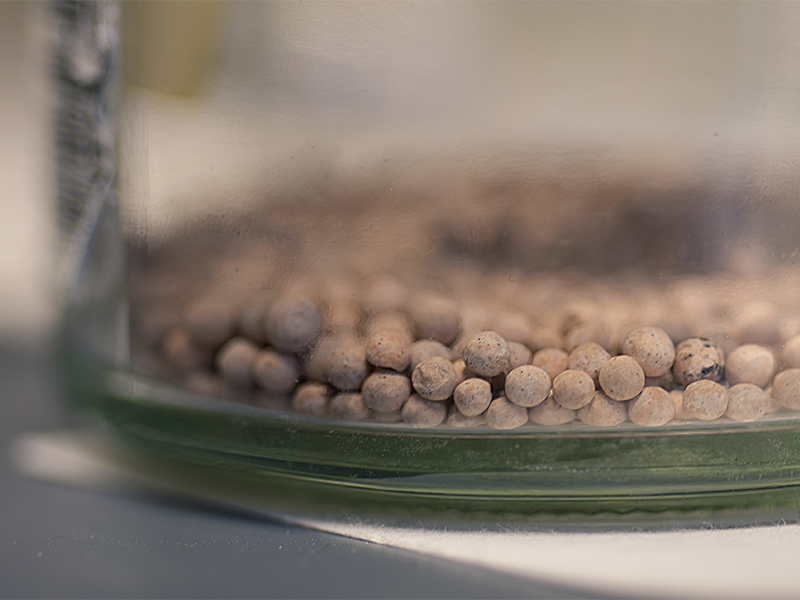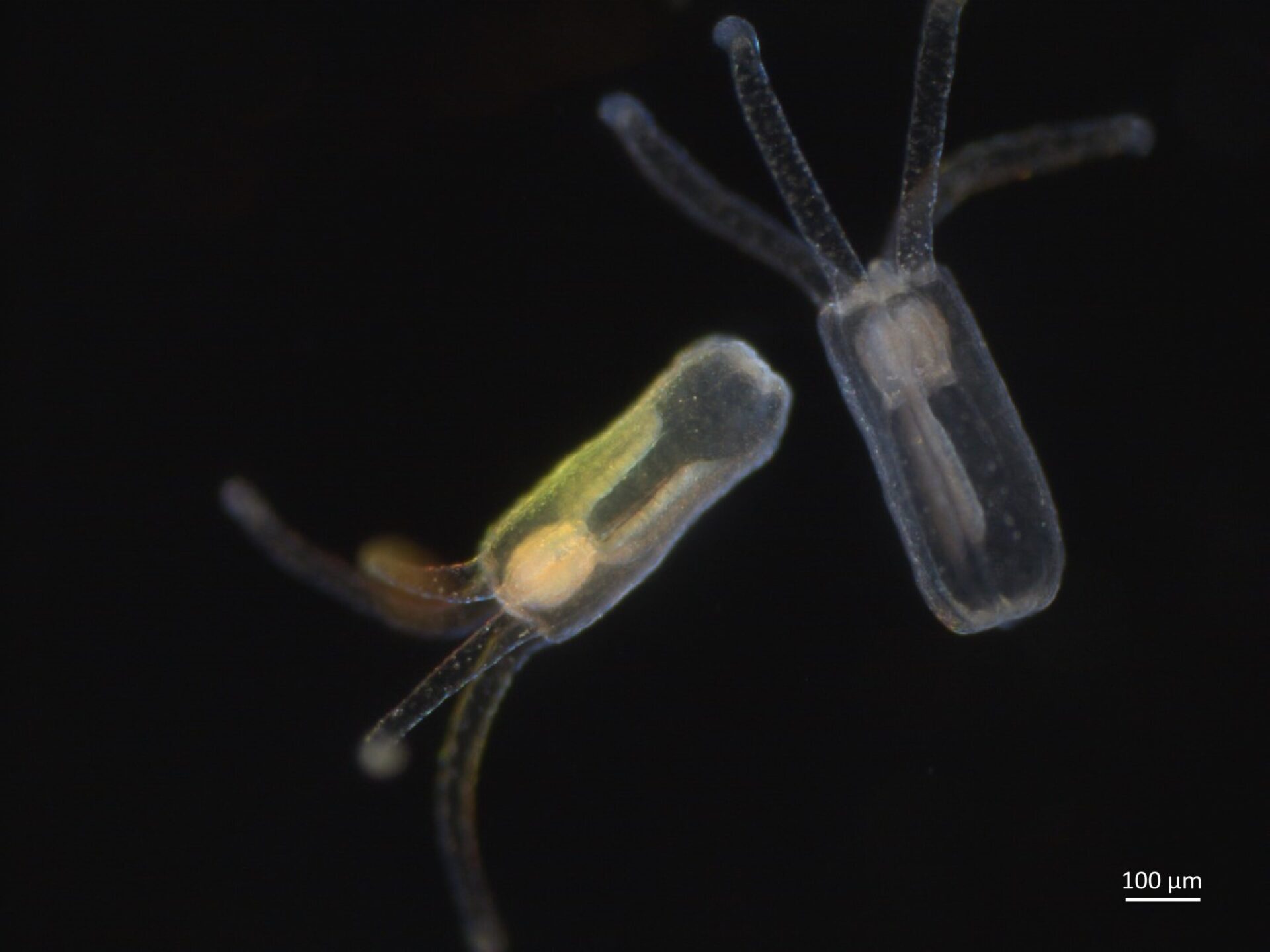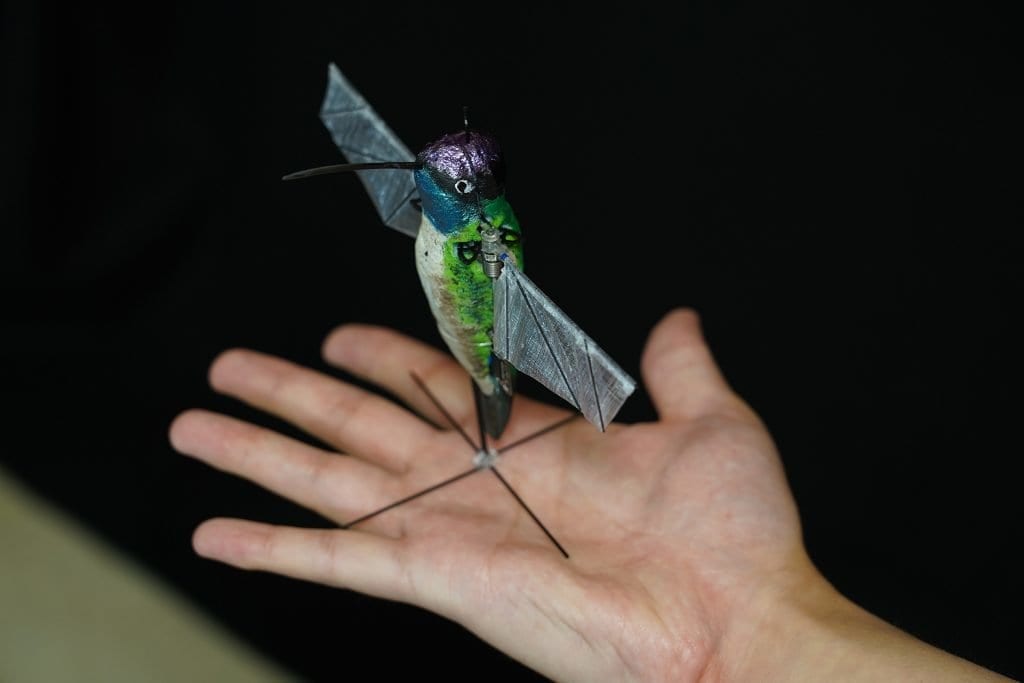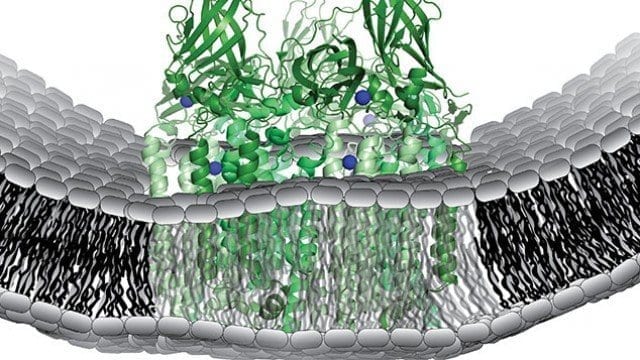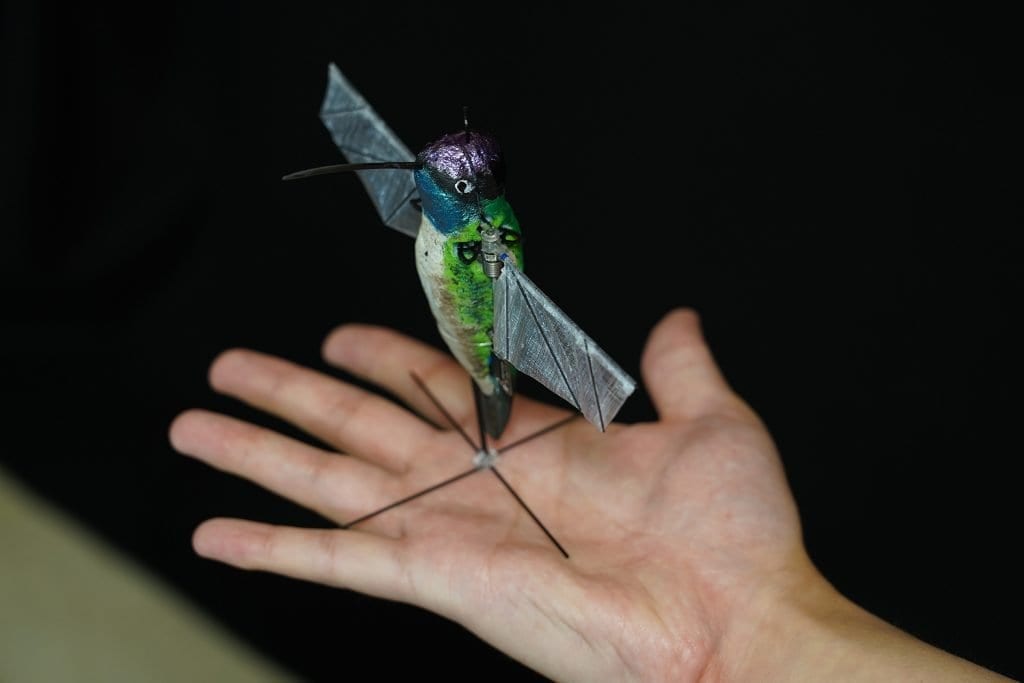
Your friendly neighborhood hummingbirds. If drones had this combo, they would be able to maneuver better through collapsed buildings and other cluttered spaces to find trapped victims.
Purdue University researchers have engineered flying robots that behave like hummingbirds, trained by machine learning algorithms based on various techniques the bird uses naturally every day.
This means that after learning from a simulation, the robot “knows” how to move around on its own like a hummingbird would, such as discerning when to perform an escape maneuver.
Artificial intelligence, combined with flexible flapping wings, also allows the robot to teach itself new tricks. Even though the robot can’t see yet, for example, it senses by touching surfaces. Each touch alters an electrical current, which the researchers realized they could track.
“The robot can essentially create a map without seeing its surroundings. This could be helpful in a situation when the robot might be searching for victims in a dark place – and it means one less sensor to add when we do give the robot the ability to see,” said Xinyan Deng, an associate professor of mechanical engineering at Purdue.
The researchers will present their work on May 20 at the 2019 IEEE International Conference on Robotics and Automation in Montreal.
Drones can’t be made infinitely smaller, due to the way conventional aerodynamics work. They wouldn’t be able to generate enough lift to support their weight.
But hummingbirds don’t use conventional aerodynamics – and their wings are resilient. “The physics is simply different; the aerodynamics is inherently unsteady, with high angles of attack and high lift. This makes it possible for smaller, flying animals to exist, and also possible for us to scale down flapping wing robots,” Deng said.
Researchers have been trying for years to decode hummingbird flight so that robots can fly where larger aircraft can’t. In 2011, the company AeroVironment, commissioned by DARPA, an agency within the U.S. Department of Defense, built a robotic hummingbird that was heavier than a real one but not as fast, with helicopter-like flight controls and limited maneuverability. It required a human to be behind a remote control at all times.
Deng’s group and her collaborators studied hummingbirds themselves for multiple summers in Montana. They documented key hummingbird maneuvers, such as making a rapid 180-degree turn, and translated them to computer algorithms that the robot could learn from when hooked up to a simulation.
Further study on the physics of insects and hummingbirds allowed Purdue researchers to build robots smaller than hummingbirds – and even as small as insects – without compromising the way they fly. The smaller the size, the greater the wing flapping frequency, and the more efficiently they fly, Deng says.
The robots have 3D-printed bodies, wings made of carbon fiber and laser-cut membranes. The researchers have built one hummingbird robot weighing 12 grams – the weight of the average adult magnificent hummingbird – and another insect-sized robot weighing 1 gram. The hummingbird robot can lift more than its own weight, up to 27 grams.
Designing their robots with higher lift gives the researchers more wiggle room to eventually add a battery and sensing technology, such as a camera or GPS. Currently, the robot needs to be tethered to an energy source while it flies – but that won’t be for much longer, the researchers say.
The robots could fly silently just as a real hummingbird does, making them more ideal for covert operations. And they stay steady through turbulence, which the researchers demonstrated by testing the dynamically scaled wings in an oil tank.
The robot requires only two motors and can control each wing independently of the other, which is how flying animals perform highly agile maneuvers in nature.
“An actual hummingbird has multiple groups of muscles to do power and steering strokes, but a robot should be as light as possible, so that you have maximum performance on minimal weight,” Deng said.
Robotic hummingbirds wouldn’t only help with search-and-rescue missions, but also would allow biologists to study hummingbirds more reliably in their natural environment through the senses of a realistic robot.
“We learned from biology to build the robot, and now biological discoveries can happen with extra help from robots,” Deng said.
Simulations of the technology are available open-source at https://github.com/purdue-biorobotics/flappy.
Learn more: Hummingbird robot using AI to go soon where drones can’t
The Latest on: Flying robots
[google_news title=”” keyword=”flying robots” num_posts=”10″ blurb_length=”0″ show_thumb=”left”]
via Google News
The Latest on: Flying robots
- TU Munich: Robots and drones to monitor and clean the environmenton April 27, 2024 at 11:17 am
Researchers at the Technical University of Munich have set themselves the goal of cleaning the environment with robots and drones. This is done remotely.
- Xpeng’s flying car affiliate AeroHT closes in on airworthiness certification as Chinese EV maker targets fourth-quarter presaleson April 26, 2024 at 11:38 pm
AeroHT, an affiliate of Chinese electric vehicle maker Xpeng, has started the countdown for the commercialisation of its flying car and plans to start taking pre-orders in the fourth quarter of this ...
- Testing Novel 3D Mapping Technology to Transform Space Exploration and Benefit Industries on Earthon April 26, 2024 at 9:03 am
The project, a collaboration between Boeing and CSIRO (an Australian government agency responsible for scientific research), highlights the importance of international partnerships while building on ...
- What's The 'Wow Cool Robot' Meme? The 'Mobile Suit Gundam' Satire Drawing Explainedon April 26, 2024 at 6:54 am
The Gundam anime series is not just about flashy and cool robot fights. Here's why this exploitable meme became a viral satire about people who miss some subtext in certain pieces of media.
- Robotic Helpers Test New Technology on the Space Stationon April 25, 2024 at 8:59 am
Researchers are using the Astrobees—named Queen, Honey and Bumble—to test innovative new technology with important applications on future spaceflight missions and back on Earth.
- Northants guide dog and robot best friends after dateon April 24, 2024 at 10:52 pm
"She started off very apprehensive, but once the treats came through, she got more involved to the point where we were able to walk the robot past Amelia with very little reaction ...
- Spiderlike Mars Robot Might One Day Crawl through Unexplored Volcanic Caveson April 17, 2024 at 11:59 am
This eight-legged probe would scour Mars’s underground lava tubes for places where explorers might camp—or for signs of past life ...
- The robots built to take over boring household taskson April 16, 2024 at 6:49 am
Recent advances in AI and robotics could make it a reality with machines such as the Tesla Optimus and Dobb-E.
- Team develops a hybrid hopping, flying roboton April 16, 2024 at 5:46 am
To develop this hybrid robot, dubbed Hopcopter, the team attached a spring-loaded telescopic leg — much like a pogo stick — to the underside of a quadcopter, enabling the robot to hop, when necessary.
- MIT Technology Reviewon April 16, 2024 at 5:10 am
The holy grail of robotics since the field’s beginning has been to build a robot that can do our housework. But for a long time, that has just been a dream. While roboticists have been able to get ...
via Bing News


